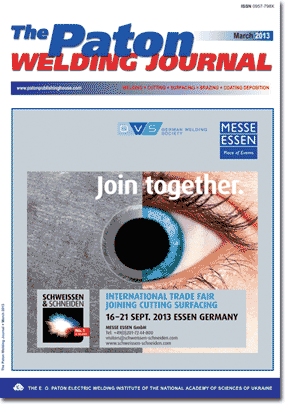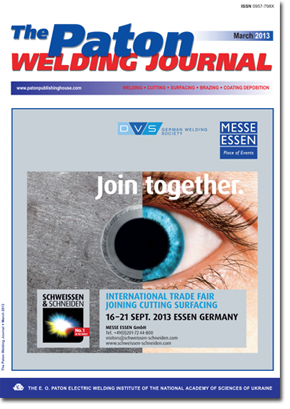| 2013 №03 (11) | 2013 №03 (02) |

The Paton Welding Journal, 2013, #3, 2-5 pages
INDICES OF PORE FORMATION IN HEAT TREATMENT OF WELDED ASSEMBLIES FROM STEELS SUSCEPTIBLE TO TEMPERING CRACKING
V.I. MAKHNENKO, O.V. MAKHNENKO, E.A. Velikoivanenko, G.F. ROZYNKA and N.I. PIVTORAK
E.O. Paton Electric Welding Institute, NASU, Kiev, Ukraine
Abstract
It is well-known fact that the welded joints from heat-resistant steel of 10GN2MFA type, widely used in power engineering, have a tendency to formation of tempering cracks. Aim of the present work was a grounded explanation of reasons of crack appearance as well as understanding of mechanisms of their preventing based on pore formation in material creep. It is shown in the work using published experimental data of Prof. I. Hryvnak on this problem and attracting modern statements of mechanism of poor formation in plastic deforming (strain ageing) that mechanism of section loss near the grain boundary in HAZ metal becomes significantly apparent in two-hour holding at 700-600 oC temperature due to pore formation at relaxation of high tempering residual stresses. Efficiency of heat treatment (relaxation of high residual stresses related with manufacture and, in particular, with repair of critical structures from considered steel) is rapidly reduced at tempering temperatures below 600 oC. Therefore, existing anxieties related with effect of modes of high tempering on appearance of tempering cracks in HAZ at fusion welding of specified type of steel are grounded enough and require particular attention to problems of determination of permissibility of corresponding repairs and development of suitable technologies on modes of post-weld heat treatment. This allows significantly reducing operation expenses. 8 Ref., 2 Tables, 3 Figures.
Keywords: tempering cracks in HAZ of low-alloy steel, strain ageing, relaxation of residual stresses, grain-boundary diffusion, pore formation
Received: 24.12.12
Published: 28.03.13
References
1. Nakamura, H., Naiki, T., Okabayashi, H. Stress relaxation cracking in the HAZ. IIW Doc. IX-648-69, X-531-69.
2. Hrivnak, I. (1984) Weldability of steels.
Ed. by E.L. Makarov. Moscow: Mashinostroenie.
3. Kachanov, L.M. (1956) Fundamentals of theory of plasticity. Moscow: Gostekhizdat.
4. Kachanov, L.M. (1961) Time of fracture under creep conditions. Problems of continuum mechanics. Moscow: AN SSSR.
5. Karzov, G.P., Margolin, B.Z., Shvetsova, V.A. (1993) Physico-mechanical modeling of fracture processes. St.-Petersburg: Politekhnika.
6. Makhnenko, V.I., Velikoivanenko, E.A., Rozynka, G.F. et al. (2012) Consideration of pore formation at estimation of limiting state in zone of pressure vessel wall thinning defect. The Paton Welding J., 12, 2-8.
7. Ruggieri, C. (2004) Numerical investigation of constraint effects on fracture in tensile specimens. J. Braz. Soc. of Mech. Sci. & Eng., 16(2), 190-199.
8. Makhnenko, V.I. (2006) Resource of safety service of welded joints and assemblies of current structures. Kiev: Naukova Dumka.
Suggested Citation
V.I. MAKHNENKO, O.V. MAKHNENKO, E.A. Velikoivanenko, G.F. ROZYNKA and N.I. PIVTORAK (2013) INDICES OF PORE FORMATION IN HEAT TREATMENT OF WELDED ASSEMBLIES FROM STEELS SUSCEPTIBLE TO TEMPERING CRACKING. The Paton Welding J., 03, 2-5.The cost of subscription/purchase order journals or individual articles
| Journal/Currency | Annual Set | 1 issue printed |
1 issue |
one article |
| TPWJ/USD | 384 $ | 32 $ | 26 $ | 13 $ |
| TPWJ/EUR | 348 € | 29 € | 24 € | 12 € |
| TPWJ/UAH | 7200 UAH | 600 UAH | 600 UAH | 280 UAH |
| AS/UAH | 1800 UAH | 300 UAH | 300 UAH | 150 UAH |
| AS/USD | 192 $ | 32 $ | 26 $ | 13 $ |
| AS/EUR | 180 € | 30 € | 25 € | 12 € |
| SEM/UAH | 1200 UAH | 300 UAH | 300 UAH | 150 UAH |
| SEM/USD | 128 $ | 32 $ | 26 $ | 13 $ |
| SEM/EUR | 120 € | 30 € | 25 € | 12 € |
| TDNK/UAH | 1200 UAH | 300 UAH | 300 UAH | 150 UAH |
| TDNK/USD | 128 $ | 32 $ | 26 $ | 13 $ |
| TDNK/EUR | 120 € | 30 € | 25 € | 15 € |
AS = «Automatic Welding» - 6 issues per year;
TPWJ = «PATON WELDING JOURNAL» - 12 issues per year;
SEM = «Electrometallurgy Today» - 4 issues per year;
TDNK = «Technical Diagnostics and Non-Destructive Testing» - 4 issues per year.


